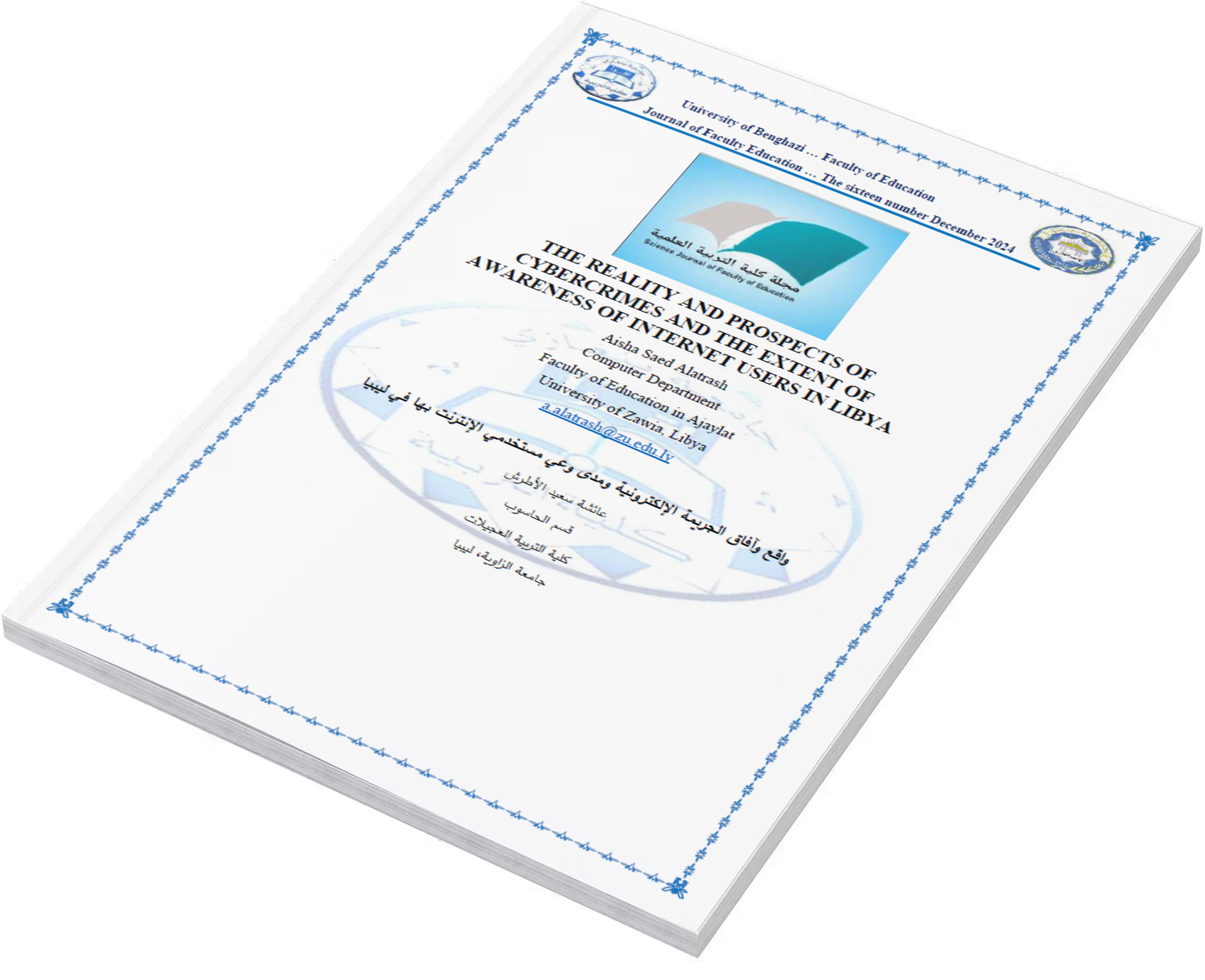Applying Technology Acceptance Model (TAM) to investigate the effectiveness of using distance-learning tools on a group of faculty members at University of Benghazi
DOI:
https://doi.org/10.37376/fesj.vi16.7103Abstract
With the emergence of the novel coronavirus disease 2019 (COVID-19) epidemic in 2020, educational organisms were forced to quickly adapt from face-to-face learning to online learning and monitoring education. It was different from digital learning platforms and tools for online teaching. Therefore, this was an important study of technology acceptance and behavioral intentions to use some learning tools after university convenience at the colleges of the University of Benghazi. For this purpose, to begin studying the technology acceptance model as a framework and extend it with different variables, including technology readiness, subjective climates, and driving conditions. Use an online questionnaire and see the data of 209 lecturers from different antiquities. Continued study on the proposed model models and equations. Given that expectations in the evening partly relate to behavioral intentions toward use, while perceived incentives will directly exert their best efforts in response. Moreover, she was independent in technology, self-consciousness, and the circumstances in which she walked on what she easily perceived. The results can serve as a reference for university professors, public administrations, and encouraging industries in accepting post-learning members among lecturers in the future as well.
Downloads
References
o السدحان، ع. (2021). فاعلية برنامج تدريبي عن بعد في تنمية مهارات استخدام نظام إدارة التعليم الإلكتروني لدى أعضاء هيئة التدريس في جامعة شقراء. مجلة جامعة أم القرى للعلوم التربوية والنفسية 13، (2) ،1-2
o بسعود، م. تيماوي، ع. (2021). استخدام تكنولوجيا التعليم الإلكتروني وفق نموذج تقبل التكنولوجيا TAM لدى أساتذة المدرسة العليا للأساتذة بالأغواط الجزائر 15، (01).
o بن الدليل، أ. (2023). تطوير نموذج قبول التكنولوجيا TAM لقياس اتجاهات أعضاء هيئة التدريس بجامعة بيشة حول استخدام نظام البلاك بورد في التدريب الإلكتروني 43، (203).
o ربوش, العارفة, براك, & خضرة. (2024). الانتاج الأكاديمي للأستاذ الجامعي ومعيقاته في ظل التعليم عن بعد: قراءة نظرية في الموضوع. Journal of Economic Geography, 1(2), 52-70.
o عبداللطيف, و محمد عبداللطيف عبدالعزيز. (2024). فعالية التعليم عن بعد عبر تطبيقات تقنية ميتافيرس (دراسة استشرافية). المجلة العلمية لدراسات الإعلام الرقمي والرأي العام, 1(2), 750-784.
o عرفة، ن، &مليجي، م. (2017). استخدام نموذج قبول التكنولوجيا لتحليل اتجاهات ونوايا طلبة الجامعات السعودية نحو الاستعانة بالتعليم الإلكتروني لمقرراتهم الدراسية. المجلة العربية لضمان جودة التعليم الجامعي، -227 .278.
o نوال علي الربيعان، & أروى متعب الدرعان. (2024). التنبؤ بقبول تقنية الواقع المعزز لدى معلمي ومعلمات العلوم باستخدام نموذج قبول التكنولوجيا (TAM). Journal of Education-Sohag University, 117(117).
References
Davis, Fred D. 1989. “Perceived Usefulness, Perceived Ease of Use, and User Acceptance of Information Technology.” MIS Quarterly: Management Information Systems 13(3):319–39. doi: 10.2307/249008.
Johnston, J. P. (2020). Creating better definitions of distance education. Online Journal of Distance Learning Administration, 23(2), 1-6.
Katane, I., Kristovska, I., & Katans, E. (2015). Evaluation of distance education environmental advantages. Engineering for rural development, 20, 720-728.
Praveen, Yarlagadda Sreshta. 2021. “Online Learning in Covid-19: A Study on the Emotional Intelligence, Self-Efficacy and Mental Well-Being of Female University Students Yarlagadda.” International Journal of Research Publication and Reviews 2(9):1175–79.
Miranda, Helena, and Michael Russell. 2011. “Predictors of Teacher-Directed Student Use of Technology in Elementary Classrooms: A Multilevel Sem Approach Using Data from the Use It Study.” Journal of Research on Technology in Education 43(4):301–23. doi: 10.1080/15391523.2011.10782574.
Nurhayati, N., Fitriah, E., Halimatusadiah, E., & Azis, R. (2023). Use of E-Learning System in Technology Acceptance Model (TAM) on Accredited PTS Students in BAN-PT Bandung. KnE Social Sciences, 221-232.
Songkram, Noawanit, and Hathaiphat Osuwan. 2022. “Applying the Technology Acceptance Model to Elucidate K-12 Teachers’ Use of Digital Learning Platforms in Thailand during the COVID-19 Pandemic.” Sustainability (Switzerland) 14(10). doi: 10.3390/su14106027.
Szulc, Jolanta. 2020. “Distance Learning – the Current Status and Directions for Further Research.” International Journal of Research in E-Learning 6(1):1–19. doi: 10.31261/ijrel.2020.6.1.02.
Teo, T., & Huang, F. (2019). Investigating the influence of individually espoused cultural values on teachers’ intentions to use educational technologies in Chinese universities. Interactive Learning Environments, 27(5-6), 813-829.

Downloads
Published
How to Cite
Issue
Section
License
Copyright (c) 2024 Science Journal of Faculty of Education

This work is licensed under a Creative Commons Attribution-NonCommercial-NoDerivatives 4.0 International License.














